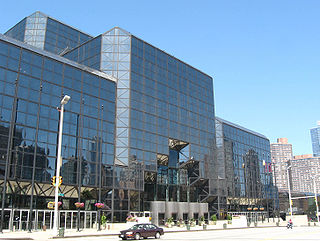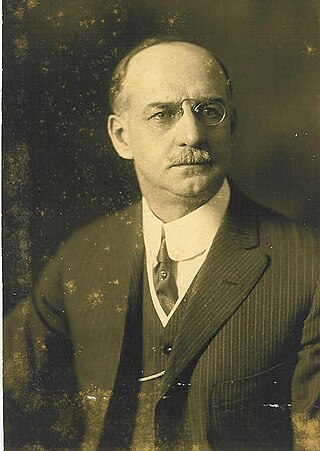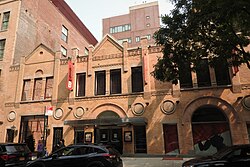
The Woolworth Building is an early American skyscraper designed by architect Cass Gilbert located at 233 Broadway in the Tribeca neighborhood of Manhattan in New York City. It was the tallest building in the world from 1913 to 1930, with a height of 792 feet (241 m). More than a century after its construction, it remains one of the 100 tallest buildings in the United States.

Eleventh Avenue is a north–south thoroughfare on the far West Side of the borough of Manhattan in New York City, located near the Hudson River. Eleventh Avenue originates in the Meatpacking District in the Greenwich Village and West Village neighborhoods at Gansevoort Street, where Eleventh Avenue, Tenth Avenue, and West Street intersect. It is considered part of the West Side Highway between 22nd and Gansevoort Streets.

The Barclay–Vesey Building is an office and residential building at 140 West Street in Lower Manhattan, New York City. The 32-story building was designed in the Art Deco style by Ralph Walker of Voorhees, Gmelin and Walker, and was Walker's first major commission as well as one of the first Art Deco skyscrapers. It occupies the entire block bounded by West Street to the west, Barclay Street to the north, Vesey Street to the south, and Washington Street to the east, abutting the World Trade Center.

65 Broadway, formerly the American Express Building, is a building on Broadway between Morris and Rector Streets in the Financial District of Manhattan in New York City. The 21-story concrete and steel-frame structure, an office building, was designed by James L. Aspinwall of the firm Renwick, Aspinwall & Tucker in the Neoclassical style. 65 Broadway extends westward through an entire block, to Trinity Place. Its most prominent feature is its H-shaped building plan, with light courts located between its wings.

The Wilbraham at 282–284 Fifth Avenue or 1 West 30th Street, in the NoMad neighborhood of Manhattan, New York City, was built in 1888–90 as a bachelor apartment hotel. Its "bachelor flats" each consisted of a bedroom and parlor, with bathroom but no kitchen; the communal dining room was on the eighth floor. The building's refined and "extraordinarily well detailed" design in commercial Romanesque revival style – which owed much to the Richardsonian Romanesque developed by H.H. Richardson – was the work of the partners David and John Jardine. The Real Estate Record and Guide in 1890 called it "quite an imposing piece of architecture".

The American Bank Note Company Building is a five-story building at 70 Broad Street in the Financial District of Manhattan in New York City. The building was designed by architects Kirby, Petit & Green in the neo-classical style, and contains almost 20,000 square feet (1,900 m2) of space, with offices and residences on the upper floors. The exterior consists of a main facade on Broad Street with two columns, as well as side facades with pilasters on Beaver and Marketfield Streets.

Ballet Hispánico is an American dance company based in Manhattan, New York. It was founded by the Puerto Rican-Mexican-American dancer and choreographer Tina Ramirez in 1970 and presents dances reflecting the experience of Hispanic and Latino Americans.

108 Leonard, formerly known as 346 Broadway, the New York Life Insurance Company Building, and the Clock Tower Building, is a residential structure in the Tribeca neighborhood of Manhattan in New York City, United States. Built from 1894 to 1898, the building was constructed for the New York Life Insurance Company. Stephen Decatur Hatch created the original plans while McKim, Mead & White oversaw the building's completion. The building occupies a city block bounded by Broadway to the west, Leonard Street to the north, Lafayette Street to the east, and Catherine Lane to the south. It is a New York City designated landmark and is listed on the National Register of Historic Places.

89th Street is a one-way street running westbound from the East River to Riverside Drive, overlooking the Hudson River, in the New York City borough of Manhattan. The street is interrupted by Central Park. It runs through the Upper West Side, Carnegie Hill and Yorkville neighborhoods.

The East 73rd Street Historic District is a block of that street on the Upper East Side of the New York City borough of Manhattan, on the south side of the street between Lexington and Third Avenues. It is a neighborhood of small rowhouses built from the mid-19th to early 20th centuries.

The Mount Morris Bank Building, also referred to as the Corn Exchange Bank and Corn Exchange Building, is an historic building in the East Harlem neighborhood of Manhattan, New York City, located at 81-85 East 125th Street on the northwest corner of Park Avenue. Although an architectural standout when new in 1883, by the late 1970s it was vacant, and remained so for three decades, vandalized and deteriorating. In 2009 the city demolished, for safety, most of what remained after a 1997 fire, but in 2012 a developer undertook to rebuild it for commercial occupancy, and the building reopened in May 2015.

The Phelan Building is an 11-story office building located at 760 Market Street in the Financial District of San Francisco, California. It has a triangular shape, similar to the Flatiron Building in Manhattan, New York City, with its tip at the meeting point of Market Street, O’Farrell Street, and Grant Avenue. It is a San Francisco Designated Landmark.

The Cunard Building, formerly the Standard & Poors Building, is a 22-story office building at 25 Broadway, across from Bowling Green Park, in the Financial District of Lower Manhattan in New York City. The Cunard Building was designed in the Italian Renaissance style by Benjamin Wistar Morris, in conjunction with consultants Carrère & Hastings. The Cunard Building's facade and principal first-floor interior spaces are New York City designated landmarks, and the building is also a contributing property to the Wall Street Historic District, a National Register of Historic Places district created in 2007.

Sherry's was a restaurant in New York City. It was established by Louis Sherry in 1880 at 38th Street and Sixth Avenue. In the 1890s, it moved to West 37th Street, near Fifth Avenue. By 1898 it had moved to the corner of 44th Street and Fifth Avenue, before moving to the Hotel New Netherland on the corner of 59th Street in 1919.

Frank Aydelott Rooke, known professionally as Frank A. Rooke, was a New York architect who designed the historic Claremont Riding Academy and numerous other structures of significance that are either in National Historic Districts or listed on the National Register of Historic Places in the tri-state area.

The Bennett Building is a cast-iron building in the Financial District of Lower Manhattan in New York City. The building is on the western side of Nassau Street, spanning the entire block from Fulton Street to Ann Street. While the Bennett Building contains a primary address of 93-99 Nassau Street, it also has entrances at 139 Fulton Street and 30 Ann Street.

The Excelsior Power Company Building is a residential building at 33–43 Gold Street in the Financial District of Manhattan in New York City. It was designed in the Romanesque Revival style by William C. Gunnell and built by Robert L. Darragh. Completed in 1889, it is Manhattan's oldest known remaining building erected specifically for commercial power generation.

The Codman Carriage House and Stable is a historic building located at 1415 22nd Street NW in the Dupont Circle neighborhood of Washington, D.C. The industrial building was constructed in 1907 as a carriage house and stable for socialite and art collector Martha Catherine Codman, who lived a few blocks north in her home, later known as the Codman–Davis House. She commissioned her cousin, Ogden Codman Jr., an architect and prominent interior decorator who also designed her home. He designed it in a Second Empire style.
Stockton Beekman Colt was an American architect noted for using the Renaissance style. A graduate of Columbia University, Colt had numerous partnerships, including working with John Stewart Barney, Goodhue Livingston, and Samuel Beck Parkman Trowbridge. He designed the Barclay Building, Nathaniel L. McCready house, and the Emmet Building in New York City.

The First Battery Armory, also known as the 102nd Medical Armory and the State Armory, is a historic National Guard armory building at 56 West 66th Street, between Central Park West and Columbus Avenue, on the Upper West Side of Manhattan in New York City, United States. The building was constructed between 1901 and 1904 and was designed by Arthur J. Horgan and Vincent J. Slattery in multiple revival architectural styles. It is composed of a symmetrical brick-and-granite headhouse to the north and a drill hall to the south. The armory is a New York City designated landmark and is listed on the National Register of Historic Places.


























